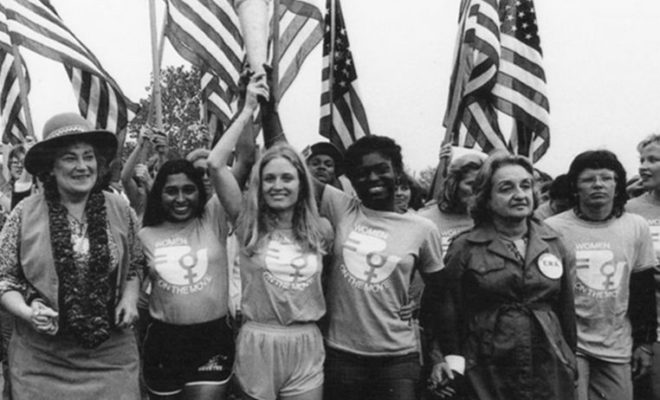
Movie Reviews
Sisters of ’77
By: Kelly Kearney
In the hour-long documentary Sisters of ’77, directors Cynthia Salzman Mondell and Allen Mondell take a look back at the first National Women’s Conference in Houston, Texas. Joined with female leaders like Bella Abzug, Gloria Steinem and Betty Freidman, the live footage film offers a front row seat to a time when twenty thousand women descended upon the city to demand their equal protections under the law. Their goals were to devise and agree on a list of their demands that would eventually be presented to the President of the United States for approval. The film includes actual footage from the conference, as well as past and present interviews from the attendees who fought tirelessly to be included and respected in their everyday lives as well as in the political arena.
A National Plan of Action
Throughout the course of the film we meet attendees and elected officials who gathered in Houston to propose a resolution consisting of twenty-six points that were most concerning to women. Those included were abortion, the rights of working women and housewives, projections for homosexuals, childcare, healthcare, welfare, indigenous rights and all the opportunities that are typically given to men. Thousands of women broke up into groups that fit their identities, by race, nationality, occupation and sexuality. It was the most diverse gathering of women in the history of modern U.S. politics and with it came the realization that diverse people have diverse ideas of which not all will agree on.
Over three days these women debated, argued, held speeches and caucused all to create one proposal that protects the basic needs of women. This was done in hopes they could convince the President of the United States to back the Equal Rights Amendment, which in turn would elicit support from the states the bill needed to be ratified. While this was taking place, across town a growing group of anti-feminists, led by Phyllis Schlafly, reminded us all that not every woman wants to be equal.
Not All Women Want the Same things
Besides the endless arguments over reproductive rights (which didn’t seem to be a topic that the black caucuses could get behind), religious leaders also refused to back any and all resolutions that included lesbians. Betty Friedman, arguably the Matriarch of the feminist movement in America, thought including lesbians in the resolution would force Washington to turn a blind eye to the ERA. She and many others didn’t see that inclusion was worth the risk, not that she didn’t wholeheartedly believe they deserved it. The year 1977 was a time when homosexuals were demonized and Betty thought society wasn’t ready to hear their cries for help. Luckily, the days spent in Houston changed her mind. Betty came around and when the vote was on the floor to include sexuality in the twenty-six points, she stood in support. The clips from her speech sent shockwaves across the floor of the arena and outside where the anti-feminist movement was growing larger by the day.
The leader of that movement, Phyllis Schlafly, had made a name for herself by injecting her ideology into every ERA discussion from the political arena to television interviews. She formed a counter conference called The Pro-Life Pro-Family Rally held at the Astro Arena. Fifteen thousand people showed up to tell the world that the feminists did not speak for all women. Her and her naysayers worked around the clock to prevent women from becoming whole members of society. Even more so, they wanted to squash any movement that gave power to women in fear they might leave the home and distance themselves from conservative family values. At the time, and still in many parts of the country today, that meant remaining a second-class citizen and subservient to men. Their ideas that women should kneel to their husbands and stay out of the workplace, was her driving force in this fight. Phyllis and her group would not stop until the ERA was dead. They used fear tactics, bigotry, propaganda and lies to gain their own powerful voices in both the women’s movement and in D.C. The irony of these women leaving the home to become lobbyists in support of taking the very rights from women who wish to leave the home was certainly lost on them, but the film highlights that in all of its glorious hypocrisy.
After days of dodging the dissenting voices and fighting over a condensed proposal that works for everyone, the women in Houston took a vote. All twenty-six resolutions were agreed upon, much to Schlafly’s dismay. Unfortunately, all their hard work wouldn’t see results until 2019 when Virginia finally became the 38th state to ratify the Equal Rights Amendment. It took four decades and by the time it passed the statute of limitations had run out. With a conservative stronghold in all four branches of government today the ratification of the ERA and the extension of the time in which it needed to pass fell on deaf ears.
The Fight for Equality Continues…
The year 1977 wasn’t a total loss. It brought women together from all walks of life to fight for one common goal. They learned from one another as they broadened their minds by stepping away from their often-privileged lives to hear the calls of distress from their sisters of the oppressed minority. It also catapulted women into politics. At the time Congress was made up of less than 5% elected female officials. Since then women have been gaining their voice and now make up almost 23% of the House of Representatives. We owe that push to the female leaders of 1977.
As for The National Women’s Conference, it was a moment in history that still resonates with our struggles today. The directors of Sisters of ’77 chose to use real clips from the Houston conference, sandwiched in between updates on how the same women feel about the movement today. It was an inspiring, but also depressing example of how far the equality movement still has to go and yet not one of those women lost their faith in the movement. The film does an excellent job of reminding us that there is power in unity and, just like the feminists of the seventies, women should never give up trying to fight for their equality. This film is a must see and a stark reminder that in the year 2020, women are still demanding their government grant them their basic civil rights. Maybe one day the men of this world will hear their cries and finally invite everyone to the table to share equally in their power. Until then, the fight continues.




You must be logged in to post a comment Login